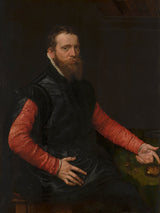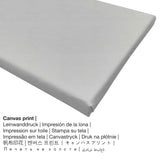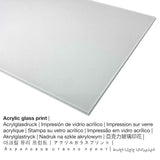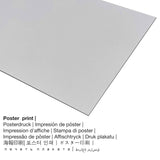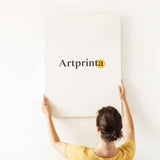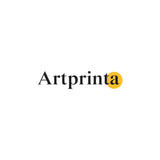Anthonis Mor van Dashorst, 1564 - Eserese ma ọ bụ Steven nke Herwijck (c.1530-1565 / 67) - mbipụta nka mara mma.
Ụtụ gụnyere. Mbupu gbakọrọ na ndenye ọpụpụ.
Onyinye ngwaahịa nka
The 16th narị afọ onye na-ese ihe kere ọrụ nka Anthonis Mor van Dashorst in 1564. The version of the artpiece had the exact size: elu: 118 cm obosara: 89 cm | elu: 46,5 n'obosara: 35 inch na e ji teknuzu nke mmanụ na panel. The artpiece has the following inscription: "dated: A[E]TATIS. XXXV. 1564". Besides, this artpiece can be viewed in in the Ndị Maurithuis art collection in The Hague, South Holland, Netherlands. We are glad to mention that the public domain work of art is being provided with courtesy of Maurithuis, Hague. The creditline of the artwork is: Sir Peter Lely, London; his sale (not in Lugt), London, 18 April 1682, unnumbered; possibly Allaert van Couwenhoven, Rotterdam, 1683; sale Nicolaes Anthonis Flinck, Rotterdam, 4 November 1754, no. 11; sale Hendrick van Kretschmar, Amsterdam, 29 March 1757, no. 13; Govert van Slingelandt, The Hague, 1754-1767; his widow, Agatha Huydecoper, The Hague, 1767-1768; Van Slingelandt sale, The Hague, 18 May 1768 (Lugt 1683), no. 9; the entire collection sold to Prince William V; Prince William V, The Hague, 1768-1795; confiscated by the French, transferred to the Muséum Central des Arts/Musée Napoléon (Musée du Louvre), Paris, 1795-1815; Royal Picture Gallery, housed in the Prince William V Gallery, The Hague, 1816; transferred to the Mauritshuis, 1822. On top of that, alignment is in Eserese format na nwere akụkụ ruru nke 3: 4, which means that the length is 25% shorter than the width. The painter Anthonis Mor van Dashorst was an artist, whose style can be classified as Mannerism. The painter lived for 56 years - born in 1519 ma nwụọ na 1575.
Nkọwa mgbakwunye site na webụsaịtị ihe ngosi nka (© - nke Mauritshuis - www.mauritshuis.nl)
Sir Peter Lely, London; his sale (not in Lugt), London, 18 April 1682, unnumbered; possibly Allaert van Couwenhoven, Rotterdam, 1683; sale Nicolaes Anthonis Flinck, Rotterdam, 4 November 1754, no. 11; sale Hendrick van Kretschmar, Amsterdam, 29 March 1757, no. 13; Govert van Slingelandt, The Hague, 1754-1767; his widow, Agatha Huydecoper, The Hague, 1767-1768; Van Slingelandt sale, The Hague, 18 May 1768 (Lugt 1683), no. 9; the entire collection sold to Prince William V; Prince William V, The Hague, 1768-1795; confiscated by the French, transferred to the Muséum Central des Arts/Musée Napoléon (Musée du Louvre), Paris, 1795-1815; Royal Picture Gallery, housed in the Prince William V Gallery, The Hague, 1816; transferred to the Mauritshuis, 1822
Ozi ndabere gbasara ọrụ nka mbụ
| Aha nka nka: | "Portrait or Steven of Herwijck (c.1530-1565 / 67)" |
| Nhazi nka: | sere |
| Otu sara mbara: | nka ochie |
| oge: | 16th narị afọ |
| Year: | 1564 |
| Afọ nka: | ihe karịrị afọ 450 |
| Ihe osise izizi: | mmanụ na panel |
| Nha nke ihe nka izizi: | elu: 118 cm obosara: 89 cm |
| Akara mbinye aka: | dated: A[E]TATIS. XXXV. 1564 |
| Ụlọ ihe ngosi nka / mkpokọta: | Maurithuis |
| Ebe ngosi nka: | Hague, South Holland, Netherlands |
| Weebụsaịtị nke ihe ngosi nka: | www.mauritshuis.nl |
| Licensedị ikike: | ngalaba ọha |
| Site n'aka: | Maurithuis, Hague |
| kreditline ọrụ nka: | Sir Peter Lely, London; his sale (not in Lugt), London, 18 April 1682, unnumbered; possibly Allaert van Couwenhoven, Rotterdam, 1683; sale Nicolaes Anthonis Flinck, Rotterdam, 4 November 1754, no. 11; sale Hendrick van Kretschmar, Amsterdam, 29 March 1757, no. 13; Govert van Slingelandt, The Hague, 1754-1767; his widow, Agatha Huydecoper, The Hague, 1767-1768; Van Slingelandt sale, The Hague, 18 May 1768 (Lugt 1683), no. 9; the entire collection sold to Prince William V; Prince William V, The Hague, 1768-1795; confiscated by the French, transferred to the Muséum Central des Arts/Musée Napoléon (Musée du Louvre), Paris, 1795-1815; Royal Picture Gallery, housed in the Prince William V Gallery, The Hague, 1816; transferred to the Mauritshuis, 1822 |
Onye na-ese ihe
| aha: | Anthonis Mor van Dashorst |
| okike nke onye nka: | nwoke |
| Ọrụ: | onye na-ese ihe |
| Nhazi nke onye nka: | nna ukwu ochie |
| Ụdị nke onye na-ese ihe: | Omume |
| Ndụ: | 56 afọ |
| Amụrụ n'afọ: | 1519 |
| Afọ nwụrụ: | 1575 |
Kedu ihe kacha amasị gị?
Maka ngwaahịa ọ bụla anyị na-enye ihe dị iche iche & nha. Ị nwere ike ịhọrọ n'ime nhọrọ nhazi ngwaahịa ndị a:
- Bipụta na iko acrylic (nke nwere ezigbo mkpuchi iko n'elu): The acrylic glass print, which is sometimes referenced as a plexiglass print, will convert your chosen artwork into lovely décor. Additionally, the acrylic art print is a distinct alternative option to aluminium or canvas fine art prints. Your artwork is custom-made with the help of modern UV print machines. This makes sharp and vivid colors. The major advantage of an acrylic glass fine art copy is that contrasts as well as granular artwork details become exposed because of the very subtle tonal gradation. The acrylic glass protects your chosen fine art print against light and heat for several decades.
- Akwụkwọ mmado ebipụtara (ihe kwaaji): A poster print is a printed flat canvas paper with a slight finish on the surface, that resembles the actual artwork. Please bear in mind, that depending on the absolute size of the canvas poster print we add a white margin 2-6cm around the print motif, which facilitates the framing.
- Mbipụta nke aluminom: Aluminium Dibond prints are prints on metal with a true depth. For our Print On Aluminum Dibond, we print your selected artpiece right onto the surface of the white-primed aluminum composite. The bright & white components of the artpiece shine with a silk gloss but without the glow. This direct print on Aluminum Dibond is one of the most demanded entry-level products and is an extremely modern way to showcase fine art prints, since it puts all of the viewer’s focus on the artwork.
- Kwaaji: The printed canvas, not to be confused with a painting on a canvas, is an image printed from a UV direct printer. A canvas generates a particular effect of three dimensionality. A canvas print has the advantage of being relatively low in weight. That means, it is easy and straightforward to hang your Canvas print without any wall-mounts. Hence, canvas prints are suitable for any kind of wall.
Nkọwa ngwaahịa ahaziri ahazi
| Bipụta ngwaahịa: | nka nka |
| Mmeputakwa: | dijitalụ mmeputakwa |
| Usoro mmepụta: | mbipụta dijitalụ |
| Nlụpụta: | Germany |
| Ụdị ngwaahịa: | mmepụta ihe na-achọ |
| Eji ngwaahịa emebere: | mgbidi mma, art ebipụta gallery |
| Nhazi nke ihe nka: | nhazi ihe osise |
| Njikwa oyiyi: | 3: 4 (ogologo: obosara) |
| Mmetụta akụkụ onyonyo: | ogologo bụ 25% mkpụmkpụ karịa obosara |
| Nhọrọ akụrụngwa: | acrylic glass print (nwere ezigbo mkpuchi iko), mbipụta akwụkwọ mmado (akwụkwọ kwaaji), mbipụta ọla (aluminium dibond), mbipụta akwụkwọ. |
| Canvas dị n'elu ihe nrịbama (mbipụta kanvas) nha dị iche iche: | 30x40cm - 12x16", 60x80cm - 24x31", 90x120cm - 35x47", 120x160cm - 47x63" |
| Mpempe iko acrylic (nwere ezigbo mkpuchi iko) nha dị iche iche: | 30x40cm - 12x16", 60x80cm - 24x31", 90x120cm - 35x47", 120x160cm - 47x63" |
| Nhọrọ nke mbipụta akwụkwọ mmado (akwụkwọ kwaaji): | 30x40cm - 12x16", 60x80cm - 24x31", 90x120cm - 35x47" |
| Aluminom dibond ọdịdị nha ebipụta: | 30x40cm - 12x16", 60x80cm - 24x31", 90x120cm - 35x47" |
| ụba: | agunyeghi |
Disclaimer: We try what we can to depict our art products in as much detail as possible and to demonstrate them visually. Still, the pigments of the print materials, as well as the printing might diverge marginally from the representation on your screen. Depending on the screen settings and the nature of the surface, color pigments may not be printed as realistically as the digital version on this website. Because the art prints are printed and processed by hand, there may also be minor deviations in the motif's exact position and the size.
Ederede a bụ ikike ọgụgụ isi ma chekwaa ya site na nwebisiinka ©, www.artprinta.com (Artprinta)

